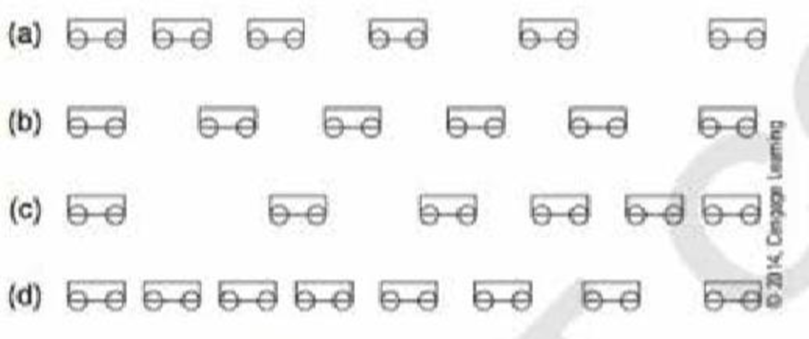
Concept explainers

These pictures show a cart that is moving at constant velocity.
(a) (b) (c) (d)
The cart that is moving at constant velocity
Answer to Problem 1PLA
Option (b)
Explanation of Solution
Constant velocity specifies that the car covers equal amount of displacement in a given time duration. The carts pictured in the question are all moving in a straight line to the left. From the picture, it is evident that the cart (b) gets displaced equally for every 1.00 s.
Conclusion:
From the picture, it is evident that the cart (b) gets displaced equally for every 1.00 s. Therefore, option (b) is correct.
The displacement of cart in (a) is increasing with time, hence the cart a is not moving with constant velocity.
The displacement of cart in (c) is decreasing with time, hence the cart a is not moving with constant velocity.
The displacement of cart in (d) is not uniform, hence the cart a is not moving with constant velocity.
Want to see more full solutions like this?
Chapter 4 Solutions
Physics Laboratory Manual
- As shown in (Figure 1), block AA (mass 2.10 kgkg) rests on a tabletop. It is connected by a horizontal cord passing over a light, frictionless pulley to a hanging block BB (mass 1.28 kgkg). The coefficient of kinetic friction between block AA and the tabletop is 0.353. The blocks are released then from rest. Find the speed of each block after moving 3.20 cm. Find the tension in the cord.arrow_forwardA rope, attached to a weight, goes up through a pulley at the ceiling and back down to a worker. The worker holds the rope at the same height as the connection point between the rope and weight. The distance from the connection point to the ceiling is 30 ft. Suppose the worker stands directly next to the weight (.e., a total rope length of 60 ft) and begins to walk away at a constant rate of 2 ft/s. How fast is the weight rising when the worker has walked: 10 feet? Answer= 30 feet? Answerarrow_forwardAn 85 kg man lowers himself to the ground from a height of 10.0 m by holding onto a rope that runs over a frictionless pulley to a 65 kg sandbag. With what speed does the man hit the ground if he started from rest?arrow_forward
- A child is standing is standing on the edge of a cliff overlooking a river. The cliff is 8m above the edge of the river and the river is 20m wide where the child is located. If the child can throw a rock with a speed of 20m/s, will the rock make it across the river?arrow_forwardLet us consider the fall of a pole vaulter as a projectile once he releases the pole. The pole has a lake of 15 8 feet and once the athlete releases the pole he will find a mattress 2 feet high, 10 feet wide and 16 feet long, which protects him in the fall. If an athlete lets go of the pole when it was 13.7 ft above the ground with a speed of 15.7 ft/s at an angle of 73 degrees. Enter the horizontal distance that the athlete will travel with the indicated conditions, add the units in the resultarrow_forwardAn archer shoots an 18.0-gram arrow at a 43.0-gram target on a wall 32.0 m high. If the arrow is shot at a velocity of v0 = 60.0 m/s, what is the speed of the arrow when it reaches the target?arrow_forward
- Carol wants to move her 32kg sofa to a different room in the house. She places "sofa disks", slippery disks with mu k =.080 , on the carpet, under the feet of the sofa. She then pushes the sofa at a steady.4 .4 m/s across the floor. How much force does she apply to the sofa?arrow_forwardA building is under construction, and a construction worker is standing on top of a 130m high elevator shaft. The worker accidentally drops his hammer down the shaft. At what speed does the hammer hit the ground?arrow_forwardA skateboard with mass of 50kg is pulled without friction across the ground by a rope that makes an angle of 20 degrees with the horizontal. What force on the rope would be required to move the skateboard at a constant speed of 20 m/s?arrow_forward
- A 4 m ladder leans against a wall. The bottom of the ladder is 1.7 m from the wall at time t = 0 sec and slides away from the wall at a rate of 0.6 m/s. Find the velocity of the top of the ladder at time i = 2 (take the direction upwards as positive). (Use decimal notation. Give your answer to three decimal places.) velocity : m/sarrow_forwardA student pushes a 12-kg block on a frictionless, horizontal surface. If the block is initially at rest, what is the speed of the block after the student pushes the block for 5 seconds with an acceleration of 2.0 m/s/s? O 2.0 m/s 6.0 m/s 10 m/s 60 m/sarrow_forwardA constant applied force of 46.0 N lifts an 2.50 kg mass straight up resulting in a final speed of 4.8 m/s. what distance did the mass move if it was initially at rest?arrow_forward
 Glencoe Physics: Principles and Problems, Student...PhysicsISBN:9780078807213Author:Paul W. ZitzewitzPublisher:Glencoe/McGraw-Hill
Glencoe Physics: Principles and Problems, Student...PhysicsISBN:9780078807213Author:Paul W. ZitzewitzPublisher:Glencoe/McGraw-Hill
